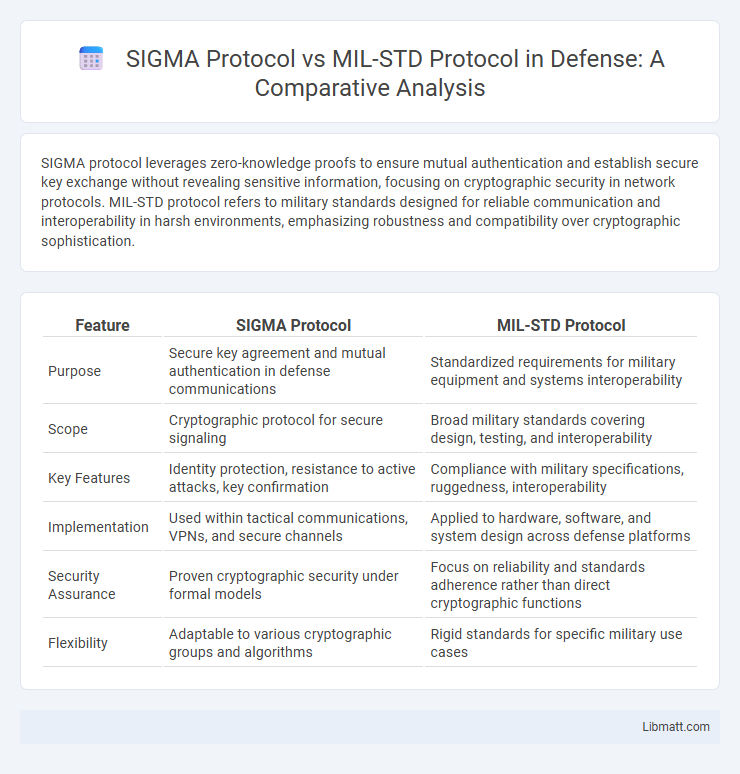SIGMA protocol leverages zero-knowledge proofs to ensure mutual authentication and establish secure key exchange without revealing sensitive information, focusing on cryptographic security in network protocols. MIL-STD protocol refers to military standards designed for reliable communication and interoperability in harsh environments, emphasizing robustness and compatibility over cryptographic sophistication.
Table of Comparison
| Feature | SIGMA Protocol | MIL-STD Protocol |
|---|---|---|
| Purpose | Secure key agreement and mutual authentication in defense communications | Standardized requirements for military equipment and systems interoperability |
| Scope | Cryptographic protocol for secure signaling | Broad military standards covering design, testing, and interoperability |
| Key Features | Identity protection, resistance to active attacks, key confirmation | Compliance with military specifications, ruggedness, interoperability |
| Implementation | Used within tactical communications, VPNs, and secure channels | Applied to hardware, software, and system design across defense platforms |
| Security Assurance | Proven cryptographic security under formal models | Focus on reliability and standards adherence rather than direct cryptographic functions |
| Flexibility | Adaptable to various cryptographic groups and algorithms | Rigid standards for specific military use cases |
Introduction to SIGMA and MIL-STD Protocols
SIGMA protocols focus on secure key exchange and mutual authentication in cryptographic systems, widely used to protect sensitive communications. MIL-STD protocols, defined by the U.S. Department of Defense, establish rigorous standards for interoperability, reliability, and security in military communications and electronic systems. Understanding the differences between SIGMA's cryptographic framework and MIL-STD's comprehensive military communication standards helps optimize your security and compliance strategies in defense and secure communications.
Overview of SIGMA Protocol
The SIGMA protocol is a cryptographic framework designed for secure key exchange and authentication, emphasizing mutual authentication between communicating parties. It combines signatures, key exchange algorithms, and message authentication codes to ensure confidentiality, integrity, and authenticity. This protocol is widely adopted in secure communications, forming the foundation for protocols such as IKE (Internet Key Exchange) used in IPsec.
Overview of MIL-STD Protocol
MIL-STD protocols, established by the U.S. Department of Defense, define rigorous communication and interoperability standards for military systems to ensure reliability, security, and efficiency in diverse operational environments. These protocols provide detailed specifications for data formats, timing, and electrical interfaces, facilitating seamless integration across various defense platforms. Emphasizing robustness and compatibility, MIL-STD protocols support mission-critical applications where precision and resilience against interference are paramount.
Key Features Comparison
The SIGMA protocol offers enhanced authentication with mutual key agreement based on Diffie-Hellman exchanges, providing strong protection against man-in-the-middle attacks and identity spoofing. In contrast, the MIL-STD protocol emphasizes standardized military communication with robust error correction and secure transmission suited for harsh operational environments. SIGMA prioritizes cryptographic security for key exchange, while MIL-STD protocols focus on interoperability and resilience in tactical data link communications.
Security Mechanisms in Both Protocols
SIGMA protocol employs advanced cryptographic techniques such as digital signatures and Diffie-Hellman key exchange to ensure mutual authentication and key confidentiality, providing robust protection against man-in-the-middle attacks. MIL-STD protocols incorporate standardized military-grade encryption algorithms and strict access controls to guarantee secure communication within defense systems, emphasizing resilience and integrity under hostile conditions. Your choice between these protocols should consider SIGMA's focus on cryptographic handshake security versus MIL-STD's comprehensive, hardware-integrated protective measures for mission-critical environments.
Performance and Efficiency Metrics
SIGMA protocol offers enhanced performance with lower latency and higher throughput compared to traditional MIL-STD protocols, making it ideal for real-time applications. Its efficiency metrics demonstrate reduced bandwidth consumption and improved error correction, ensuring reliable communication in challenging environments. Your choice between SIGMA and MIL-STD should consider mission-critical performance needs and available system resources.
Implementation and Compliance Considerations
SIGMA protocol offers simplified implementation with fewer hardware demands, making it suitable for systems requiring rapid deployment and cost-efficiency, whereas MIL-STD protocols demand strict adherence to government-mandated standards with comprehensive compliance testing and certification processes. MIL-STD protocols emphasize rigorous documentation and traceability, ensuring interoperability and reliability in defense and aerospace applications, while SIGMA's flexibility allows easier customization but may lack uniform regulatory approval. Compliance with MIL-STD involves extensive validation and audit trails, crucial for mission-critical systems, contrasting with SIGMA's lighter compliance framework catering to commercial and non-military sectors.
Use Cases and Industry Applications
The SIGMA protocol excels in secure key exchange for encrypted communication in financial services and mobile networks, ensuring robust authentication and confidentiality. MIL-STD protocols are widely adopted in defense and aerospace industries for reliable, standardized communication under harsh environmental conditions and mission-critical operations. Use cases for SIGMA emphasize cryptographic security in commercial sectors, while MIL-STD protocols prioritize durability and interoperability in military and industrial applications.
Challenges and Limitations
SIGMA protocol faces challenges in scalability and integration with existing MIL-STD systems, leading to potential interoperability issues in military communications. MIL-STD protocol limitations include rigidity and slower adaptation to emerging technologies, impacting real-time data transmission efficiency. Your decision between these protocols should consider the balance between innovation flexibility and established system reliability.
Future Developments and Trends
SIGMA protocol anticipates advancements in cryptographic agility and enhanced resistance to quantum attacks, promoting scalable security for next-generation communication systems. MIL-STD protocol developments focus on integration with evolving defense technology standards and improved interoperability across multi-domain operations for robust military communication networks. Both protocols are trending towards increased automation and adaptive security frameworks to support dynamic threat environments and mission-critical applications.
SIGMA protocol vs MIL-STD protocol Infographic

 libmatt.com
libmatt.com